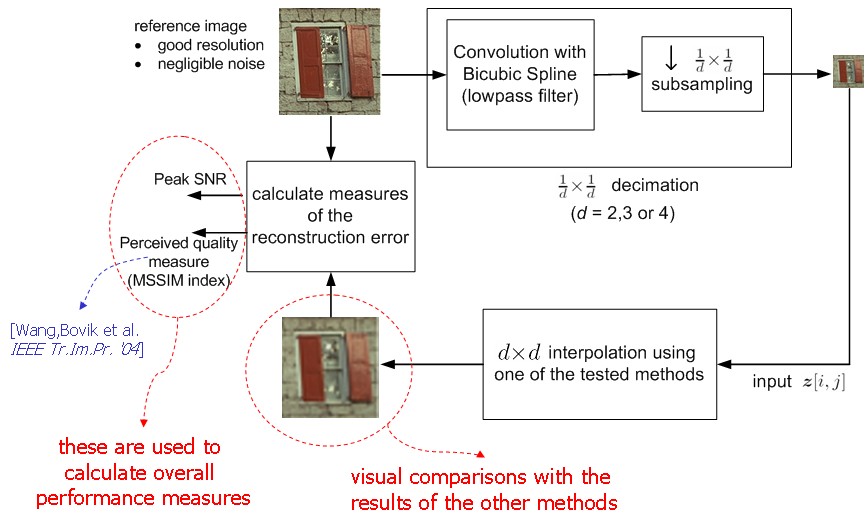Corresponding Publications:
[1] A. Roussos and P. Maragos, Vector-Valued Image Interpolation by an Anisotropic Diffusion-Projection PDE, SSVM 2007.
[2] A. Roussos and P. Maragos, Reversible Interpolation of Vectorial Images by an Anisotropic Diffusion-Projection PDE, International Journal of Computer Vision, vol. 84, no. 2, pp. 130-145, Aug. 2009.
Options:
-
Go to the Results Table, which contains links to all the experimental results
-
Download the Results
-
View the dataset of CIPR that we have used
Details about the experimental framework that we have followed:

In order to compare the interpolation methods and extract performance measures, we use the following framework: We choose a reference image with a relatively good resolution and negligible noise. We reduce the dimensions of this image by an integer factor d (i.e. the image is reduced to 1/d x 1/d of its size), using a decimation process, i.e. (anti-aliasing) lowpass filtering followed by subsampling. We implement the lowpass filtering by a convolution with a bicubic spline, which results to a reliable and commonly used decimation process. Finally, we apply the interpolation methods to enlarge the decimated image by the zoom factor d, so that the output images have the same size as the reference image. Note that we used the range [0,255] for image values and in the case of color, we applied the methods representing the images in the RGB color space. The reference image can be considered as the ideal output of the interpolation, as it is noiseless. Therefore the difference between the reference image r[i,j] and the output of a method u[i,j] can be viewed as reconstruction error and is quite representable of the method performance.
We use two measures for this error, the classic peak signal-to-noise-ratio (PSNR):
![]()
and the mean structural similarity (MSSIM) index [Wang,Bovik et al., IEEE Tr.Im.Pr. '04], which seems to approximate the perceived visual quality of an image better than PSNR or various other measures. MSSIM index takes values in [0,1] and increases as the quality increases. We calculate it based on the code available here, using the default parameters. In the case of color images, we extend MSSIM with the simplest way: we calculate the MSSIM index of each RGB channel and then take the average.
We repeat the above procedure for different reference images from a dataset and for zoom factors d =2,3 and 4. For every zoom factor and interpolation method, we compute the averages of PSNR and MSSIM for all the images in the set, which we consider as final measures of performance.
We followed the above experimental framework using a dataset of 23 natural images of size 768×512 pixels. We run two series of experiments, the first for the graylevel versions (where we applied bicubic, Total Variation (TV) - based, Belahmidi-Guichard (BG), the previous [1] and the current version [2] of the proposed method) and the second for their color counterparts (where we applied bicubic, Tscumperle-Deriche and again the previous and current version of our method ). Note that we have not applied TV-based and BG methods to color images because they are designed for the interpolation of graylevel images only.
For the methods that needed specification of parameter(s), we utilized fixed values in all the dataset, which we empirically derived based on the quality of the results, as perceived by a human observer. We have hence chosen the parameters σ=0.3d, ρ=0.4d, r=0.35d and K=1 for both versions of the proposed method. Also, in TD method we used the same values ρ=0.4d, K=1 and in BG method we used K=3 for the corresponding threshold constant.
Overall Performance Measures:

Graylevel experiments: Average error measures in all results using the graylevel images of the dataset.
